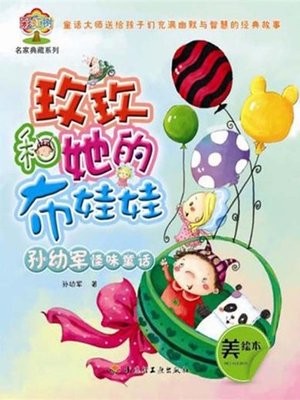
Sign up to save your library
With an OverDrive account, you can save your favorite libraries for at-a-glance information about availability. Find out more about OverDrive accounts.
Find this title in Libby, the library reading app by OverDrive.



Search for a digital library with this title
Title found at these libraries:
| Library Name | Distance |
|---|---|
| Loading... |
我写低幼童话是从给娃娃讲故事开始的。最早是我读小学三四年级时,下面有三个弟弟、一个妹妹,我有责任哄他们玩儿。当时我已经能囫囵吞枣地读《西游记》了,我发现用自己的话给他们讲,可以让他们老实下来,不再"造反",效果相当好。后来外出求学,我身上竟有个让同房间朋友讨厌的"招孩子"的毛病,到哪里身边都有一帮孩子纠缠不休,找我要图画书看,要我讲故事。我后来故事的特点跟这很有关系,例如,给弟弟妹妹讲故事时我就发现,讲一个普通孩子上学,就不如讲一个用会说话的木头制作的孩子上学的故事受欢迎,这样,我的故事就都是童话了。1960~1961 年我写了十几篇幼儿童话,整整齐齐抄录在一个漂亮的笔记本上,包括《萤火虫找朋友》、《大蝴蝶历险记》和《一粒麦子》。那是我最早的童话,都是数百字到千余字的短小童话。后来,我在讲故事的实践中发现,那些短小的东西很难满足孩子。我自己先后的两个娃娃更是贪得无厌,睡前讲那种千把字的童话根本无法满足他们,不"再讲一个"就不肯睡觉。结果是一连讲五六个,不同的情节,杂乱的人物,把他们的小脑袋瓜儿完全搞乱了。这样,我开始试讲一些篇幅长些的,每次讲一个就可以过关,也试写一些从5000 字至8000 字的童话。收在这里的《妮妮画猴儿》和《玫玫和她的布娃娃》都属这一种。孩子睡前和幼儿园上课,这样篇幅的童话是很合适的。但我却困难起来,虽然向我索稿的刊物很多,但是他们或是嫌"读者对象是低幼儿童,程度偏低",或是嫌"篇幅过长"———低幼儿童刊物一律只要五六百字的"豆腐干儿"式的小童话。我这种童话几乎没地方发表。"需要"是一回事,习惯势力是另一回事,后者往往更强大。我按需要走,也按习惯走。这里展现的就是这两种童话。《我叫粗尾巴》也属短小的类型,我前年、去年新完成的一批。从1960 年开始,"小童话"跨度竟有半个世纪之久。(My writing tales for children at a young age started with telling stories to them.At first, when I was in 3rd and 4th grade in primary school, I assumed the responsibility to take care of and play with 3 younger brothers and 1 little sister.At that time I was able to read Journey to the West despite my limited understanding, and I found that telling stories from the book to them in my own words had a good effect on them in that they calmed down and stopped "rebelling".Later I went to study away from home when I found myself with a "mysterious power to attract kids" and my roommate disliked the power. Wherever I went, I would always be surrounded by a crowd of kids, who borrowed picture books from me and asked me to tell stories.The development of my life had a lot to do with this. For example, when telling brothers and the sister stories, I found that an ordinary kid's school life was less welcome than that of a talking kid made of wood. In this way, all my stories tended to become tales.From 1960 to 1961 I wrote more than ten tales for young-age children and made a clean copy of them in a pretty notebook, including Fire Flies Looking for Friends, Adventures of a Large Butterfly and A Grain of Wheat.Those are my earliest tales which are short in length with from hundreds of words to slightly over a thousand words.Later in my story-telling practices, I found that stories that were short could hardly satisfy the children.My two kids were way more demanding and greedy in that bed stories around one thousand words couldn't satisfy them at all and they refused to sleep without hearing "one more".Usually it ended up with five or six stories with separate plots and scrambled characters, which messed their little brains up.In this way I started trying to tell some long stories and I could pass the bed story test by telling just one. Then I tried writing longer tales with from 5000 to 8000 words.Nini Drawing Monkey and Meimei and Her Doll, included in the book, are both of the kind.Tales in this length are quite suitable for bed time stories and materials in kindergarten classes.But my situation became difficult in that although many periodicals invited me to write stories for them, they only favored "little pieces" in five or six hundred words, thinking either that targeted audience were too young to read or the stories were way too long.My stories could hardly find a place to publish.However, "demand" is one thing, while the force of habit is another, which may often be more powerful.I followed the demand as well as habit.The stories in the book are representatives of the two kinds of tales.My Name Is Thick Tail is short and is one of the new works I finished last year and the year before last year."Short tales" has spanned as long as half a century since 1960.)







